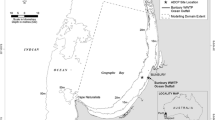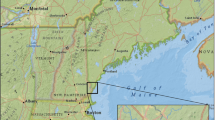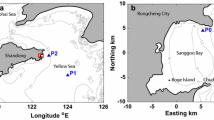Abstract
Along the coast of Maine, USA, there are numerous wastewater treatment plants that discharge their treated effluents into a river estuary which is shared by commercial fishing and shellfish harvesting. Occasionally, there can be failures or bypasses of treatment plants that lead to untreated or partially treated sewage flowing into shellfish harvesting waters. To prevent any toxic contamination of harvested shellfish, a prohibitive zone is established around the treatment plant where shellfish harvesting is prohibited. The U.S. Food and Drug Administration has conducted numerous dye studies on both coasts of the USA to determine these prohibitive zones, based on the guidelines of the National Shellfish Sanitation Program. In May 2010, the FDA conducted such a dye study at the Yarmouth, Maine wastewater treatment plant. The results are compared with a numerical coastal model that provides the velocity field for the currents around the treatment plant. This model includes a diffusion equation to simulate dye dispersion from a point source which is used to determine the prohibitive zone. The numerical model shows good correlation with the FDA dye study report and establishes a prohibitive zone for commercial harvesting in keeping with that of the FDA study. The benefits of the numerical model include sampling at thousands of locations simultaneously, seasonal changes in river volumes, and changes in plant discharge volumes.










Similar content being viewed by others
References
Ao, Y., Goblick, G. N. (2016). Application of hydrodynamic modeling to predict viral impacts from wastewater treatment plant discharges adjacent to shellfish growing areas. Office of Food Safety Center for Food Safety and Applied Nutrition, U.S. Food and Drug Administration, 5100 Paint Branch Parkway, College Park, MD 20740. https://www.epa.gov/sites/production/files/2016-06/documents/application-hydrodynamic-modeling.pdf.
Blumberg, A. F. (1991). A primer for ECOM-si, technical report (p. 66). Mahwah: HydroQual.
Chen, C., Liu, H., & Beardsley, R. (2003). An unstructured grid, finite volume, three dimensional, primitive equations ocean model: application to coastal ocean and estuaries. Journal of Atmospheric and Ocean Technology, 20(1), 159–186.
Falconer, R. A. (1984). A mathematical model study of the flushing characteristics of a shallow Tidal Bay. Proceedings of the Institute of Civil Engineers, Part 2, 77, 311–332.
Falconer, R. A. (1986). A water quality simulations study of natural harbour. Journal of Waterway Port, Coastal and Ocean Engineering ASCE, 112, 234–259.
FOCB (n.d.). Friends of Casco Bay, 43 Slocum Drive, South Portland, Maine 04106. http://www.friendsofcascobay.org/.
Frick, W. E. (2004). Visual plumes mixing zone modeling software. Environmental Modeling & Software, 19, 645–654.
Frick, W.E., Roberts, P.J.W., Davis, L.R., Keyes, J., Baumgartner, D.J., George, K.P. (2003) Dilution models for effluent discharges (Visual Plumes). EPA/600/R-03/025, fourth ed. U.S. Environmental Protection Agency, Environmental Research Division, NERL, Standards and Applied Science Division, Office of Science and Technology, Athens, Georgia.
Ganju, N. K., Brush, M. J., Rashleigh, B., Aretxabaleta, A. L., del Barrio, P., Grear, J. S., Harris, L. A., Lake, S. J., McCardell, G., O’Donnell, J., Ralston, D. K., Signell, R. P., Testa, J. M., & Vaudrey, J. M. P. (2016). Progress and challenges in coupled hydrodynamic-ecological estuarine modeling. Estuaries and Coasts, 39, 311–332.
Goblick, G. N., Ao, Y., Anbarchian, J. M., & Calci, K. R. (2017). Determination of buildup and dilution of wastewater effluent in shellfish growing waters through a modified application of super-position. Marine Pollution Bulletin, 115, 164–171.
Gupta, I., Dhage, S., Jacob, N., Navada, S. V., & Kumar, R. (2006). Calibration and validation of far field dilution models for outfall at Worli, Mumbai. Environmental Monitoring and Assessment, 114, 199–209.
Hamrick, J. M. (1996). User’s manual for the environmental fluid dynamics computer code. Special Report in Marine Science and Ocean Engineering No. 331, The College of William and Mary, Virginia Institute of Marine Science, VA. Environmental Research, 70, 150–161.
Kilpatrick, F.A. (1993). Techniques of water-resources investigations of the United States Geological Survey: simulation of soluble waste transport and buildup in surface waters using tracers. United States Geological Survey, Chapter A20, Book 3, Application of Hydraulics, Report Number: TWRI3A20. Washington, DC: US Government Printing Office, Washington, DC: US Geologic Survey, pp. 2–14.
Lemagie, E. P., & Lerczak, J. A. (2015). A comparison of bulk estuarine turnover timescales to particle tracking timescales using a model of the Yaquina Bay Estuary. Estuaries and Coasts, 38, 1797–1814.
Liu, W. C., Kuo, J. T., Young, C. C., & Wu, M. C. (2007). Evaluation of marine outfall with three-dimensional hydrodynamic and water quality modeling. Environmental Modelling Assessment, 12, 201–211.
MDMR (n.d.). Shellfish harvesting area classification-notification of changes, Oct. 2013 http://www.maine.gov/dmr/rm/public_health/closures/14.pdf.
Mellor, G. L., & Yamada, T. (1982). Development of a turbulence closure model for geophysical fluid problems. Reviews Geophysics Space Physics, 20, 85–875.
Muhammetoglu, A., Talcin, O. B., & Ozcan, T. (2012). Prediction of wastewater dilution and indicator bacteria concentrations for marine outfall systems. Marine Environmental Research, 78, 53–63.
Mukai, A.Y., Westerink, J.J., Luettich, R.A., Mark, D. (2002). Eastcoast 2001, a tidal constituent database for western North Atlantic, Gulf of Mexico, and Caribbean Sea. Contract Number DACW 42-00-C-0006, U.S. Army Research and Development Center (ERDC), Coastal and Hydraulics Laboratory (CHL), Vicksburg, MS.
Permit-Yarmouth (2017). Website for Yarmouth WWTP Permit # ME0100765. https://www.epa.gov/sites/production/files/2017-05/documents/draftme0100765permit.pdf.
Sanitation-Survey (2018). MDMR website for how shellfish areas are classified. http://www.maine.gov/dmr/shellfish-sanitation-management/programs/growingareas/howclassified.html.
Shewchuk, J.R. (n.d.). Triangle. https://www.cs.cmu.edu/~quake/triangle.html.
Signell, R. P., Jenter, H. L., Blumberg, A. F. (1996). Circulation and effluent dilution modeling in Massachusetts Bay: model implementation, verification and results. USGS Open File Report 96-015, U.S. Geological Survey, Woods Hole.
Signell, R. P., Jenter, H. L., & Blumberg, A. F. (2000). Predicting the physical effects of relocating Boston’s sewage outfall. Estuarine, Coastal and Shelf Science, 50, 59–72.
Smagorinsky, J. (1963). General circulation experiments with the primitive equations. Monthly Weather Reviews, 1, 99–164.
Smith, K. W., Bilgli, A. (n.d.) BatTri 2-D triangular grid generator. http://www-nml.dartmouth.edu/Software/battri.
U.S. Food and Drug Administration (2013). Hydrographic study of waste water treatment plant effluent in the Royal and Cousins River of Yarmouth, Maine. Report on findings from the May 24–26, 2010 study period. U.S. Food and Drug Administration, Washington, D.C. (YarmouthStudy_Final.pdf at http://www.casconorwich.org/pages/YarmouthWWTP.html).
Yotsukura, N., Kilpatrick, F.A. (1973). Tracer simulation of soluble waste concentration. Journal of the Environmental Division, American Society of Civil Engineers, vol. 99, no. EE4, Proceedings Paper 9947, pp. 499–515.
Zhao, L., Chen, C., Beardsley, R.C., Codiga, D.L., Leo, W.S. (2016). Simulations of hydrodynamics and water quality in the Massachusetts Bay system during 2014 using the bays eutrophication model. Boston: Massachusetts Water Resources Authority. Report 2016-03. 103 pp. http://www.mwra.state.ma.us/harbor/enquad/pdf/2016-03.pdf.
Acknowledgements
The author thanks Greg Goblick, FDA Consumer Safety Officer, for assistance in comparing model results with the FDA study. Also, thanks to Tom Connolly, Director, Yarmouth Wastewater Treatment Plant, for additional information on plant operation. Special thanks to the reviewers for their many helpful suggestions that greatly improved this work and made it more readable.
Author information
Authors and Affiliations
Corresponding author
Rights and permissions
About this article
Cite this article
True, E.D. Using a Numerical Model to Track the Discharge of a Wastewater Treatment Plant in a Tidal Estuary. Water Air Soil Pollut 229, 267 (2018). https://doi.org/10.1007/s11270-018-3923-x
Received:
Accepted:
Published:
DOI: https://doi.org/10.1007/s11270-018-3923-x




